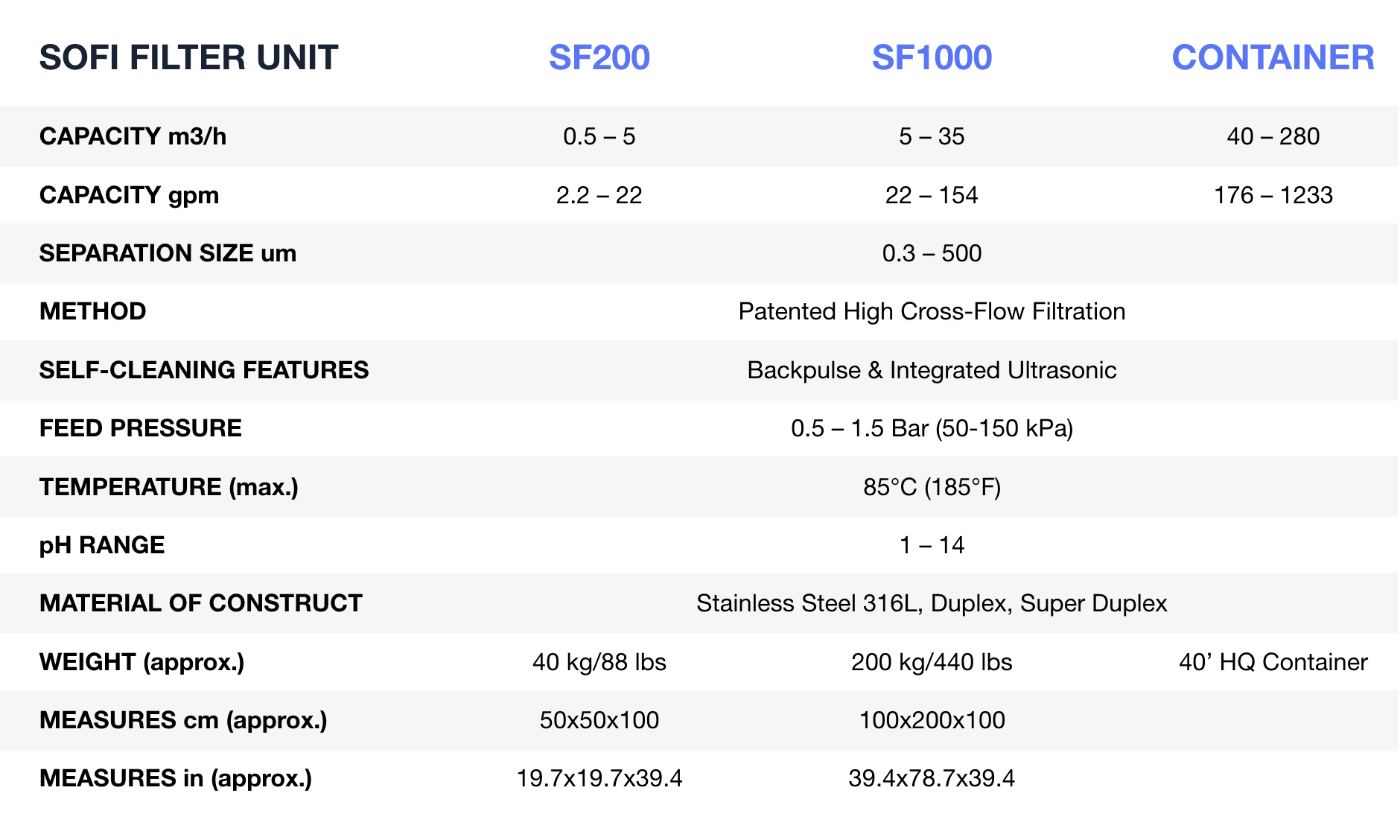Smart filtration of industrial wastewater using Sofi’s mechanically self cleaning filter
Purifying wastewater for reuse
Sofi is advantaged primarily due to its lower footprint, reliability, and simplicity of operation.
New brochure!
Download our new Sofi Filter® brochure and read how our filters can be utilized in different applications.
Download PDF (1.5MB)
Our product offering
SF200
Our SF200 is a compact filter particularly suitable for experimentation (e.g. pilot plants) and for small scale applications. It travels conveniently on a pallet if you wish to keep it mobile. Alternatively, it can be permanently installed at your site where it requires a very small floor space.
The SF200 has a filtration area of 0.2 m² and a capacity up to 5 m³/h, it comes with its own datalogging system and the filtration and cleaning procedures are fully automatic.
SF1000
Our SF1000 is an effective filter for industrial environments where high quality filtrate is required, and capacity requirements are high. By replicating the SF1000, even high capacity requirements can be met. With our filters requiring no chemicals and being automatically self-cleaning, operational costs and operator intervention are minimized. The SF1000 has a filtration area of 1 m² and a capacity up to 35 m³/h. Our SF1000 has a small space requirement and can replace larger treatment equipment while satisfying even the most demanding filtrate quality requirements. We also offer a data platform that enables remote monitoring and troubleshooting.
CONTAINER
Our filtration container is a solution for remote locations, for when protection against the elements is important or when you need your equipment only periodically or need it to move around.
The container is either 20’ or 40’ and contains either three or six SF1000 filters and all auxiliary equipment. The capacity of the containerized solution is up to 200 m³/h, depending on the feed characteristics and the number of SF1000 units.
Solids-free filtrate
Watch how it works
Main technology features and advantages
Removal of very fine solid particles down to 0.3 μm
Ultrasonic cleaning function and air back-pulse preventing clogging and fouling of the filter element.
Ability to automatically change recirculation rates and cleaning cycles to handling varying feedwater.
Well equipped with IoT features for remote monitoring and control
Scalable technology with a small footprint and low operating costs
Patented Innovative Technology
Sustainable Filter Element
Our filter elements are made of metal and thus durable and have a long lifetime.
Ultrasonic Self-cleaning
Assisted by ultrasound and back pulsing, we can keep our filter medium clean and performing to your desired needs.
Novel Cross Flow Design
Our cross flow design allows for high flux while keeping particles from fouling the filter element.
Customer Benefits
Low-cost Maintenance
You do not have to manually exchange wearables saving you time and money while promoting process and occupational safety.
Chemical Free
We don’t need to use chemicals for cleaning thus saving you money and promoting process and occupational safety.
Minimum operator intervention
Our filter is automatically self-cleaning and you don’t need to worry about replacing the filter medium.
Technical specs
Frequently Asked questions
-
Yes, our solution is modular. To increase in capacity, we just multiply in units. Our filters are very effective in floor space, don’t require large vacuum pumps, don’t use chemicals, don’t have regularly disposable parts, and are automatically self-cleaning to promote minimum operator intervention.
-
The quantity of reject depends on the solids loading (total suspended solids, TSS) of the feed and on the system configuration (cross-flow, dead-end). To understand the range, for high TSS the water recovery is around 70% (i.e. 30 % of the feed end up as reject) and for low TSS water recovery is up to 99 % (i.e. down to 1 % of the feed ends up as reject).
-
Reject handling is very dependent on the application and the actual site, as different treatment options are available at different site. Some sites have filter presses, clarifiers, or other up-stream processing where the reject can be sent to. Some sites collect the reject into a dewatering bag and transport it elsewhere for processing, since the quantity of reject from our filters is typically very low. Some sites, in turn, burn the reject for energy or can send it back to the process for the solids to be used again. We work together with our customers in identifying the most suitable option.
-
No. We separate solid particles that are detrimental for any treatment where you aim to separate dissolved material. We collaborate with other companies in understanding the requirements for solute separation and offer our filters as an effective pre-treatment option.
-
Our filters are highly durable even in aggressive environments. Standard maximum feed temperature is 85 °C. With special components maximum temperature can be increased up to 115°C.
-
Our filters use low feed pressures (0.5–1.5 bars). Typically, energy consumption is approximately 0.5 kWh/m3 purified water, including the pump, the ultrasounds and compressed air consumption.
-
Typically, 25 L/min at 6-8 bar pressure.
-
As default, the filters come equipped with pressure and flow sensors. For further monitoring, e.g. pH, conductivity, and temperature sensors can be installed.
-
Yes. We can supply you with a digital solution for data collection and remote monitoring that enables us to access the data and remotely monitor and do diagnostics for our filters to aid you in troubleshooting.
-
We can provide you with regular chemical cleaning and maintenance of your filters once in operation. We help you when you need spare parts or want new filter elements of the same or different pore size.














